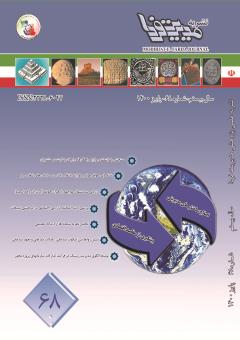شناسایی بازیگران مؤثر شبکه معاملات ارز در سامانه نیما به کمک تحلیل شبکههای اجتماعی
محورهای موضوعی : مدیریت فناوری اطلاعاتمهرداد آقا محمد علی کرمانی 1 , محمد جواد رخصت طلب 2 , سعید میرزا محمدی 3
1 - استادیار دانشکده مهندسی پیشرفت، دانشگاه علم و صنعت ایران
2 - دانش آموخته مهندسی سیستم های کلان اقتصادی اجتماعی، دانشگاه علم و صنعت ایران
3 - استادیار دانشکده پیشرفت، دانشگاه علم و صنعت ایران
کلید واژه: خریدوفروش ارز, تحلیل شبکههای اجتماعی, رتبهبندی بازیگران, سامانه نیما,
چکیده مقاله :
نظام یکپارچه معاملات ارزی که بهاختصار «نیما» نامیده میشود، بستری است که با هدف مدیریت بازار ارز طراحی و پیادهسازی شده است. با راهاندازی کامل سامانه نیما عملیات ارزی عرضه و تقاضای تجاری کشور بهطورکلی از بستر این سامانه انجام خواهد شد. بهاینترتیب که در سمت عرضه، صادرکنندگان میتوانند ارز حاصل از صادرات خود را بفروشند و در سمت تقاضا، واردکنندگان درخواست خرید ارز نمایند. شناسایی بازیگران مؤثر در هریک از این بازارها میتواند تأثیر مثبتی در سیاستگذاریهای بازار ساز اصلی این سامانه یعنی بانک مرکزی داشته باشد. در این میان استفاده از ابزارهای تحلیل شبکههای اجتماعی میتواند راهکار مناسبی برای تحقق این امر باشد. از آن جا که در این شبکهها هریک از بازیگران تنها میتواند یکی از نقشهای "خریدار" یا "فروشنده" ارز را داشته باشد و تنها امکان معامله و ایجاد ارتباط با نقش مقابل وجود دارد، میتوان این شبکهها را شبکههای دو وجهی نامید که بهمنظور تحلیل آنها ما از یک الگوریتم تصویرسازی وزنی استفاده کردیم. بعد از تصویرکردن هریک از دو شبکه عرضه و تقاضای ارز، چهار شبکه جدید شامل شبکه صادرکنندههای فروشنده ارز، صرافیهای خریدار ارز، واردکنندههای خریدار ارز و صرافیهای فروشنده ارز ایجاد گردید. در ادامه هم یک الگوریتم رتبهبندی برای گرهها ارائه شد که بر اساس آن گرهای که بالاترین رتبه را کسب کرده است مهمترین گره در شبکه مدنظر ما خواهد بود. در نهایت نیز جهت ارائه پیشنهاداتی به سیاستگذار، با تحلیل و بررسی نتایج رتبهبندی، به پرسشهایی در مورد بازیگران مؤثر بازار پاسخ داده شد.
Nima system is an integrated system of foreign exchange transactions. Nima is a platform system that has been designed and implemented with the aim of managing the foreign exchange market. In this system, on the supply side, exporters can sell the currency from their exports, and on the demand side, importers can request to buy foreign currency. Identifying effective actors in each of these markets can have a positive impact on the policies of the main market maker of this system, the central bank.Using social networks analysis (SNA) tools can be a good way to achieve this. Since in these networks each of the actors can only have one of the roles of "buyer" or "seller" and there is only the possibility of trading and communication with the opposite role, these networks can be called bipartite networks. As a result, the usual approaches to identifying effective actors for these networks will not be usable. In contrast to standard approaches, we used a weighted projection algorithm to solve this problem. After projectting each of the two networks of foreign exchange supply and demand, four new networks are created, including the network of seller-exporters, buyer exchange offices, buyer importers, and seller exchange offices. Then We will try to make a method to score and rank the nodes. As a result of the implementation of the algorithm, a ranking was provided for the nodes, based on which the node with the highest rank will be the most important node in our network. Finally, in order to make suggestions to the policymaker, by analyzing the results of the ranking, questions about effective market players were answered.
Jackson, M. O. (2010). Social and economic networks. Princeton university press
Pesántez Cabrera, P. G. (2018). Bipartite Network Community Detection: Algorithms and Applications
Xiao, B., Huang, M., & Barnes, A. J. (2015). Network closure among sellers and buyers in social commerce community. Electronic Commerce Research and Applications, 14(6), 641-653.
Wang, J. C., & Chiu, C. C. (2008). Recommending trusted online auction sellers using social network analysis. Expert Systems with Applications, 34(3), 1666-1679.
Lam, H. W., & Wu, C. (2009, May). Finding influential ebay buyers for viral marketing a conceptual model of BuyerRank. In 2009 International Conference on Advanced Information Networking and Applications (pp. 778-785). IEEE.
Leem, B., & Chun, H. (2014). An impact of online recommendation network on demand. Expert systems with applications, 41(4), 1723-1729.
Dreżewski, R., Sepielak, J., & Filipkowski, W. (2015). The application of social network analysis algorithms in a system supporting money laundering detection. Information Sciences, 295, 18-32.
Giurca, A., & Metz, T. (2018). A social network analysis of Germany’s wood-based bioeconomy: Social capital and shared beliefs. Environmental innovation and societal transitions, 26, 1-14.
Lin, S. J., Jheng, Y. Y., & Yu, C. H. (2012). Combining ranking concept and social network analysis to detect collusive groups in online auctions. Expert Systems with Applications, 39(10), 9079-9086
Cheah, I., & Shimul, A. S. (2018). Consumer ethnocentrism, market mavenism and social network analysis. Australasian Marketing Journal (AMJ), 26(3), 281-288.
Newman, M. E., & Girvan, M. (2004). Finding and evaluating community structure in networks. Physical review E, 69(2), 026113
Alzahrani, T., & Horadam, K. J. (2016). Community detection in bipartite networks: Algorithms and case studies. In Complex systems and networks (pp. 25-50). Springer, Berlin, Heidelberg.
Guimerà, R., Sales-Pardo, M., & Amaral, L. A. N. (2007). Module identification in bipartite and directed networks. Physical Review E, 76(3), 036102.
Barber, M. J. (2007). Modularity and community detection in bipartite networks. Physical Review E, 76(6), 066102
Fortunato, S. (2010). Community detection in graphs. Physics reports, 486(3-5), 75-174
Liu, J., Xiong, Q., Shi, W., Shi, X., & Wang, K. (2016). Evaluating the importance of nodes in complex networks. Physica A: Statistical Mechanics and its Applications, 452, 209-219.
Yadav, V., Karmakar, S., Kalbar, P. P., & Dikshit, A. K. (2019). PyTOPS: A Python based tool for TOPSIS. SoftwareX, 9, 217-22


